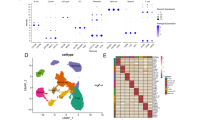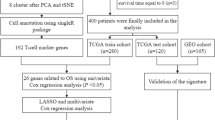Abstract
Purpose
Neuroblastoma is a challenging pediatric tumor with a need for improved treatment strategies. This study explores the role of disulfidptosis, a form of cell death induced by intracellular disulfide accumulation, in neuroblastoma and its implications for prognosis and immune infiltration.
Methods
We subgrouped neuroblastoma samples based on disulfidptosis-related gene expression and constructed a disulfidptosis potential index (DPI) to quantify disulfidptosis levels in neurobalstoma. The correlation between DPI, outcome, immune infiltration, and drug sensitivity were explored.
Results
Combing RNA-seq and single-cell dataset, we found that higher disulfidptosis potential index (DPI) is associated with poorer outcomes in neuroblastoma patients, indicating the detrimental impact of enhanced disulfide stress and cellular dysfunction. Furthermore, we found that higher DPI is correlated with reduced immune infiltration within the tumor microenvironment, highlighting an immunosuppressive milieu in high DPI neuroblastomas. The DPI-high neuroblastoma may benefit from the estrogen pathway related drug fulvestrant.
Conclusion
Overall, this study highlights the significance of disulfidptosis as a potential therapeutic target and underscores the importance of integrating immune modulation strategies, offering new avenues for improved management of neuroblastoma.





Similar content being viewed by others
Data availability
The data analyzed in this study were obtained from Gene Expression Omnibus (GEO) at GSE49710, ArrayExpress at E-MTAB-8248. The codes used during the current study are available from the corresponding author upon reasonable request.
References
Almstedt E, Elgendy R, Hekmati N, Rosen E, Warn C, Olsen TK, Dyberg C, Doroszko M, Larsson I, Sundstrom A, Arsenian Henriksson M, Pahlman S, Bexell D, Vanlandewijck M, Kogner P, Jornsten R, Krona C, Nelander S (2020) Integrative discovery of treatments for high-risk neuroblastoma. Nat Commun 11:71
Anderson J, Majzner RG, Sondel PM (2022) Immunotherapy of neuroblastoma: facts and hopes. Clin Cancer Res 28:3196–3206
Armideo E, Callahan C, Madonia L (2017) Immunotherapy for high-risk neuroblastoma: management of side effects and complications. J Adv Pract Oncol 8:44–55
Badia IMP, Velez Santiago J, Braunger J, Geiss C, Dimitrov D, Muller-Dott S, Taus P, Dugourd A, Holland CH, Ramirez Flores RO, Saez-Rodriguez J (2022) decoupleR: ensemble of computational methods to infer biological activities from omics data. Bioinform Adv 2:vbac016
Becht E, Giraldo NA, Lacroix L, Buttard B, Elarouci N, Petitprez F, Selves J, Laurent-Puig P, Sautes-Fridman C, Fridman WH, de Reynies A (2016) Estimating the population abundance of tissue-infiltrating immune and stromal cell populations using gene expression. Genome Biol 17:218
Charoentong P, Finotello F, Angelova M, Mayer C, Efremova M, Rieder D, Hackl H, Trajanoski Z (2017) Pan-cancer immunogenomic analyses reveal genotype-immunophenotype relationships and predictors of response to checkpoint blockade. Cell Rep 18:248–262
Crunkhorn S (2021) Dual-targeting CAR-T cells in neuroblastoma. Nat Rev Drug Discov 20:816
Gong Y, Fan Z, Luo G, Yang C, Huang Q, Fan K, Cheng H, Jin K, Ni Q, Yu X, Liu C (2019) The role of necroptosis in cancer biology and therapy. Mol Cancer 18:100
Ham J, Costa C, Sano R, Lochmann TL, Sennott EM, Patel NU, Dastur A, Gomez-Caraballo M, Krytska K, Hata AN, Floros KV, Hughes MT, Jakubik CT, Heisey DA, Ferrell JT, Bristol ML, March RJ, Yates C, Hicks MA, Nakajima W, Gowda M, Windle BE, Dozmorov MG, Garnett MJ, McDermott U, Harada H, Taylor SM, Morgan IM, Benes CH, Engelman JA, Mosse YP, Faber AC (2016) Exploitation of the apoptosis-primed state of MYCN-amplified neuroblastoma to develop a potent and specific targeted therapy combination. Cancer Cell 29:159–172
Hanzelmann S, Castelo R, Guinney J (2013) GSVA: gene set variation analysis for microarray and RNA-seq data. BMC Bioinformatics 14:7
Jiang P, Gu S, Pan D, Fu J, Sahu A, Hu X, Li Z, Traugh N, Bu X, Li B, Liu J, Freeman GJ, Brown MA, Wucherpfennig KW, Liu XS (2018) Signatures of T cell dysfunction and exclusion predict cancer immunotherapy response. Nat Med 24:1550–1558
Kitanaka C, Kato K, Ijiri R, Sakurada K, Tomiyama A, Noguchi K, Nagashima Y, Nakagawara A, Momoi T, Toyoda Y, Kigasawa H, Nishi T, Shirouzu M, Yokoyama S, Tanaka Y, Kuchino Y (2002) Increased Ras expression and caspase-independent neuroblastoma cell death: possible mechanism of spontaneous neuroblastoma regression. J Natl Cancer Inst 94:358–368
Li Y, Nakagawara A (2013) Apoptotic cell death in neuroblastoma. Cells 2:432–459
Li W, Li X, Xia Y, Wang J (2022) Pyroptosis-related gene signature predicts the prognosis and immune infiltration in neuroblastoma. Front Genet 13:809587
Liu X, Nie L, Zhang Y, Yan Y, Wang C, Colic M, Olszewski K, Horbath A, Chen X, Lei G, Mao C, Wu S, Zhuang L, Poyurovsky MV, James You M, Hart T, Billadeau DD, Chen J, Gan B (2023) Actin cytoskeleton vulnerability to disulfide stress mediates disulfidptosis. Nat Cell Biol 25:404–414
Machesky LM (2023) Deadly actin collapse by disulfidptosis. Nat Cell Biol 25:375–376
Maeser D, Gruener RF, Huang RS (2021) oncoPredict: an R package for predicting in vivo or cancer patient drug response and biomarkers from cell line screening data. Brief Bioinform 22:bbab60
Morgenstern DA, Bagatell R, Cohn SL, Hogarty MD, Maris JM, Moreno L, Park JR, Pearson AD, Schleiermacher G, Valteau-Couanet D, London WB, Irwin MS (2019) The challenge of defining “ultra-high-risk” neuroblastoma. Pediatr Blood Cancer 66:e27556
Nicolai S, Pieraccioli M, Peschiaroli A, Melino G, Raschella G (2015) Neuroblastoma: oncogenic mechanisms and therapeutic exploitation of necroptosis. Cell Death Dis 6:e2010
Ritchie ME, Phipson B, Wu D, Hu Y, Law CW, Shi W, Smyth GK (2015) limma powers differential expression analyses for RNA-sequencing and microarray studies. Nucleic Acids Res 43:e47
Schubert M, Klinger B, Klunemann M, Sieber A, Uhlitz F, Sauer S, Garnett MJ, Bluthgen N, Saez-Rodriguez J (2018) Perturbation-response genes reveal signaling footprints in cancer gene expression. Nat Commun 9:20
Smith V, Foster J (2018) High-risk neuroblastoma treatment review. Children (Basel) 5:114
Malta TM, Sokolov A, Gentles AJ, Burzykowski T, Poisson L, Weinstein JN, Kaminska B, Huelsken J, Omberg L, Gevaert O, Colaprico A, Czerwinska P, Mazurek S, Mishra L, Heyn H, Krasnitz A, Godwin AK, Lazar AJ, Cancer Genome Atlas Research, Stuart NJM, Hoadley KA, Laird PW, Noushmehr H, Wiznerowicz M (2018) Machine learning identifies stemness features associated with oncogenic dedifferentiation. Cell 173:338-354e315
Valter K, Zhivotovsky B, Gogvadze V (2018) Cell death-based treatment of neuroblastoma. Cell Death Dis 9:113
Wienke J, Dierselhuis MP, Tytgat GAM, Kunkele A, Nierkens S, Molenaar JJ (2021) The immune landscape of neuroblastoma: Challenges and opportunities for novel therapeutic strategies in pediatric oncology. Eur J Cancer 144:123–150
Wilkerson MD, Hayes DN (2010) ConsensusClusterPlus: a class discovery tool with confidence assessments and item tracking. Bioinformatics 26:1572–1573
Wu T, Hu E, Xu S, Chen M, Guo P, Dai Z, Feng T, Zhou L, Tang W, Zhan L, Fu X, Liu S, Bo X, Yu G (2021) clusterProfiler 4.0: A universal enrichment tool for interpreting omics data. Innovation (Camb) 2:100141
Yeku OO, Longo DL (2023) CAR T cells for neuroblastoma. N Engl J Med 388:1328–1331
Yoshihara K, Shahmoradgoli M, Martinez E, Vegesna R, Kim H, Torres-Garcia W, Trevino V, Shen H, Laird PW, Levine DA, Carter SL, Getz G, Stemke-Hale K, Mills GB, Verhaak RG (2013) Inferring tumour purity and stromal and immune cell admixture from expression data. Nat Commun 4:2612
Zafar A, Wang W, Liu G, Wang X, Xian W, McKeon F, Foster J, Zhou J, Zhang R (2021) Molecular targeting therapies for neuroblastoma: Progress and challenges. Med Res Rev 41:961–1021
Zeng D, Ye Z, Shen R, Yu G, Wu J, Xiong Y, Zhou R, Qiu W, Huang N, Sun L, Li X, Bin J, Liao Y, Shi M, Liao W (2021) IOBR: multi-omics immuno-oncology biological research to decode tumor microenvironment and signatures. Front Immunol 12:687975
Zhao Q, Liu Y, Zhang Y, Meng L, Wei J, Wang B, Wang H, Xin Y, Dong L, Jiang X (2020) Role and toxicity of radiation therapy in neuroblastoma patients: a literature review. Crit Rev Oncol Hematol 149:102924
Acknowledgements
We would like to acknowledge Selina Jansky and Frank Westermann from the German Cancer Research Center for kindly providing single-cell neuroblastoma datasets.
Funding
This work was supported by grants from the Tianjin Health Technology Project (Grant no. 2022QN106).
Author information
Authors and Affiliations
Contributions
A.Z. performed data analysis and original draft writing; X.L. and J.W. reviewed and edited the manuscript; J.W. performed the study concept and design; J.W. is the guarantor of this work and takes responsibility for the integrity of the data and accuracy of the data analysis. All the authors have read and approved the final manuscript.
Corresponding authors
Ethics declarations
Conflict of interest
The authors declare that they have no competing interests.
Ethics approval
As all data analyzed in this study were obtained from publicly available datasets, no ethics approval form was required for this manuscript.
Additional information
Publisher's Note
Springer Nature remains neutral with regard to jurisdictional claims in published maps and institutional affiliations.
Supplementary Information
Below is the link to the electronic supplementary material.
432_2023_5392_MOESM2_ESM.tif
Supplementary file2 (TIF 8716 KB) Supplementary Figure 2 | Expression Distribution of Disulfidptosis-Related Gene Set across Clusters
432_2023_5392_MOESM4_ESM.tif
Supplementary file4 (TIF 3635 KB) Supplementary Figure 4 | Enrichment Analysis Results of GSEA in DPI-High and DPI-Low Groups
432_2023_5392_MOESM5_ESM.tif
Supplementary file5 (TIF 933 KB) Supplementary Figure 5 | Enhanced Estrogen Signaling Pathway Activity and Drug Sensitivity in High-DPI Neuroblastomas in Validation Cohort
Rights and permissions
Springer Nature or its licensor (e.g. a society or other partner) holds exclusive rights to this article under a publishing agreement with the author(s) or other rightsholder(s); author self-archiving of the accepted manuscript version of this article is solely governed by the terms of such publishing agreement and applicable law.
About this article
Cite this article
Zhu, A., Li, X. & Wang, J. Integrating bulk-seq and single-cell-seq reveals disulfidptosis potential index associating with neuroblastoma prognosis and immune infiltration. J Cancer Res Clin Oncol 149, 16647–16658 (2023). https://doi.org/10.1007/s00432-023-05392-9
Received:
Accepted:
Published:
Issue Date:
DOI: https://doi.org/10.1007/s00432-023-05392-9




